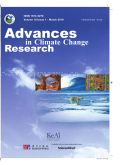- 钛学术文献服务平台 \
- 学术期刊 \
- 基础科学期刊 \
- 天文学、地球科学期刊 \
- 气候变化研究进展(英文版)期刊 \
New perspectives on'warming-wetting' trend in Xinjiang, China
New perspectives on'warming-wetting' trend in Xinjiang, China
基本信息来源于合作网站,原文需代理用户跳转至来源网站获取
摘要:
Recently, a hot topic about warmer and wetter climate change in the arid region of Northwest China, especially in Xinjiang, has attracted much attention by general public and scientific community. This study revisits this topic especially for Xinjiang in the Eurasian continental context from multiple perspectives based on most updated CRU high-resolution grid data and China's homogenized station data in 1961-2019. We conclude that such'warming-wetting' trend is not a regional phenomenon for Xinjiang but has much larger spatial scale. Regions having experienced both temperature and precipitation increases reflecting 'warming-wetting' trend account for more than half of the Eurasian continent since 1961. Nevertheless, the'warming-wetting' trend in Xinjiang suggests some unique regional features in response to the global warming. Although drought seems to have relieved to some extent, especially in the mountainous regions in western Xinjiang, the nature of arid and semi-arid climate regime has not changed. Noticeably, the interannual variability of precipitation has enlarged and the increase in extreme precipitation events has a major contribution. These findings suggest that 'warming-wetting' trend in Xinjiang is asymmetric regarding warming and wetting in seasons and intensifying interannual variability and increasing contribution of extreme precipitation to the total. Thus, the current'warming-wetting' trend in Xinjiang possibly brings us some beneficial impacts for the ecosystem but also increases challenges for water resources utilization and risk management.

推荐文章
内容分析
关键词云
关键词热度
相关文献总数
(/次)
(/年)
文献信息
| 篇名 | New perspectives on'warming-wetting' trend in Xinjiang, China | ||
| 来源期刊 | 气候变化研究进展(英文版) | 学科 | |
| 关键词 | |||
| 年,卷(期) | 2020,(3) | 所属期刊栏目 | Changes in climate system |
| 研究方向 | 页码范围 | 252-260 | |
| 页数 | 9页 | 分类号 | |
| 字数 | 语种 | 英文 | |
| DOI | |||
五维指标
引文网络
引文网络
二级参考文献 (72)
共引文献 (716)
参考文献 (34)
节点文献
引证文献 (0)
同被引文献 (0)
二级引证文献 (0)
1948(2)
- 参考文献(2)
- 二级参考文献(0)
1968(1)
- 参考文献(1)
- 二级参考文献(0)
1990(1)
- 参考文献(0)
- 二级参考文献(1)
1991(1)
- 参考文献(0)
- 二级参考文献(1)
1997(2)
- 参考文献(0)
- 二级参考文献(2)
1998(1)
- 参考文献(0)
- 二级参考文献(1)
1999(2)
- 参考文献(1)
- 二级参考文献(1)
2000(5)
- 参考文献(1)
- 二级参考文献(4)
2001(2)
- 参考文献(0)
- 二级参考文献(2)
2002(7)
- 参考文献(0)
- 二级参考文献(7)
2003(3)
- 参考文献(1)
- 二级参考文献(2)
2004(1)
- 参考文献(0)
- 二级参考文献(1)
2005(2)
- 参考文献(1)
- 二级参考文献(1)
2006(1)
- 参考文献(0)
- 二级参考文献(1)
2007(6)
- 参考文献(1)
- 二级参考文献(5)
2008(4)
- 参考文献(0)
- 二级参考文献(4)
2009(11)
- 参考文献(1)
- 二级参考文献(10)
2010(13)
- 参考文献(4)
- 二级参考文献(9)
2011(6)
- 参考文献(4)
- 二级参考文献(2)
2012(5)
- 参考文献(1)
- 二级参考文献(4)
2013(9)
- 参考文献(2)
- 二级参考文献(7)
2014(7)
- 参考文献(3)
- 二级参考文献(4)
2015(3)
- 参考文献(2)
- 二级参考文献(1)
2016(4)
- 参考文献(2)
- 二级参考文献(2)
2017(5)
- 参考文献(5)
- 二级参考文献(0)
2019(2)
- 参考文献(2)
- 二级参考文献(0)
2020(0)
- 参考文献(0)
- 二级参考文献(0)
- 引证文献(0)
- 二级引证文献(0)
引文网络交叉学科
相关学者/机构
期刊影响力
气候变化研究进展(英文版)
主办单位:
国家气候中心
出版周期:
季刊
ISSN:
1674-9278
CN:
11-5918/ P
开本:
16开
出版地:
北京市中关村南大街46号国家气候中心
邮发代号:
创刊时间:
2010
语种:
eng
出版文献量(篇)
377
总下载数(次)
0
总被引数(次)
708
期刊文献
相关文献
推荐文献
- 期刊分类
- 期刊(年)
- 期刊(期)
- 期刊推荐
力学
化学
地球物理学
地质学
基础科学综合
大学学报
天文学
天文学、地球科学
数学
气象学
海洋学
物理学
生物学
生物科学
自然地理学和测绘学
自然科学总论
自然科学理论与方法
资源科学
非线性科学与系统科学
气候变化研究进展(英文版)2022
气候变化研究进展(英文版)2021
气候变化研究进展(英文版)2020
气候变化研究进展(英文版)2019
气候变化研究进展(英文版)2018
气候变化研究进展(英文版)2017
气候变化研究进展(英文版)2016
气候变化研究进展(英文版)2015
气候变化研究进展(英文版)2014
气候变化研究进展(英文版)2013
气候变化研究进展(英文版)2012
气候变化研究进展(英文版)2011
气候变化研究进展(英文版)2010

 免费查重
免费查重










